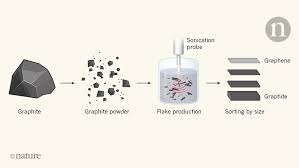
How to Identify Fake Graphene?
Graphene, renowned for its remarkable properties, has garnered widespread attention across industries. However, the surge in demand for this advanced material has also led to an influx of counterfeit or substandard graphene products. Identifying fake graphene is crucial to ensure quality and achieve the desired performance in applications.
What is Fake Graphene?
Fake graphene refers to materials marketed as graphene but failing to meet the standard definition or properties of true graphene. These materials often include:
- Graphite Oxide: A precursor to graphene, lacking the structural and electrical properties of graphene.
- Graphene Oxide (GO): While useful, GO is chemically different and not the same as pure graphene.
- Thin Graphite Sheets: Layers of graphite exfoliated into thin sheets but not reduced to monolayer or few-layer graphene.
Key Characteristics of True Graphene
- Monolayer Structure:
- True graphene consists of a single layer of carbon atoms arranged in a hexagonal lattice.
- High Electrical Conductivity:
- Exhibits exceptional conductivity due to its unique electron mobility.
- Thermal Conductivity:
- Possesses superior thermal conductivity, ideal for heat dissipation applications.
- Mechanical Strength:
- Known for its extraordinary tensile strength and flexibility.
- Optical Transparency:
- Displays high transparency while maintaining conductivity.
Methods to Identify Fake Graphene
- Raman Spectroscopy:
- Analyze the material’s structure through characteristic peaks, such as the G-band and 2D-band.
- True graphene shows a sharp 2D-band indicative of its monolayer structure.
- X-Ray Diffraction (XRD):
- Detects crystalline structures. Graphene exhibits unique XRD patterns distinct from graphite or GO.
- Scanning Electron Microscopy (SEM):
- Provides visual confirmation of the material’s layer structure and thickness.
- Atomic Force Microscopy (AFM):
- Measures thickness; monolayer graphene is approximately 0.34 nanometers thick.
- Conductivity Testing:
- True graphene demonstrates significantly higher electrical conductivity compared to GO or graphite.
- Surface Area Measurement:
- Graphene’s high surface area (>2600 m²/g) can be measured to verify its authenticity.
Common Indicators of Fake Graphene
- Exaggerated Claims:
- Vendors promising unrealistically low costs or properties that seem too good to be true.
- Opaque Appearance:
- True graphene is highly transparent; opaque materials are often graphite or multilayer graphene.
- Lack of Certification:
- Authentic graphene suppliers provide detailed characterization reports, including Raman spectra and surface area measurements.
- Low Conductivity:
- Inferior electrical or thermal conductivity indicates substandard material.
Why Identifying Fake Graphene Matters
- Performance Issues:
- Substandard graphene fails to deliver the expected performance in applications like electronics, composites, and energy storage.
- Economic Losses:
- Purchasing fake materials leads to wasted resources and financial setbacks.
- Reputation Risk:
- Using counterfeit graphene can harm a company’s credibility and brand image.
Best Practices for Avoiding Fake Graphene
- Source from Trusted Suppliers:
- Purchase graphene from reputable manufacturers with a proven track record.
- Request Detailed Characterization:
- Ensure the supplier provides technical data and test results verifying the material’s authenticity.
- Conduct Independent Testing:
- Verify the material’s properties through third-party laboratories.
- Educate Your Team:
- Train personnel to recognize the properties and standards of true graphene.
Conclusion
As graphene continues to revolutionize industries, ensuring its authenticity is paramount. By understanding the key characteristics of true graphene and employing reliable testing methods, researchers and industries can protect themselves from counterfeit products and harness graphene’s full potential. Vigilance and informed purchasing decisions will pave the way for innovation and success in graphene applications.
